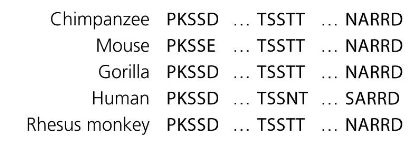What would researchers have to demonstrate to convince you that they had discovered life on another planet?
Table of contents
- 1. Introduction to Biology2h 42m
- 2. Chemistry3h 40m
- 3. Water1h 26m
- 4. Biomolecules2h 23m
- 5. Cell Components2h 26m
- 6. The Membrane2h 31m
- 7. Energy and Metabolism2h 0m
- 8. Respiration2h 40m
- 9. Photosynthesis2h 49m
- 10. Cell Signaling59m
- 11. Cell Division2h 47m
- 12. Meiosis2h 0m
- 13. Mendelian Genetics4h 44m
- Introduction to Mendel's Experiments7m
- Genotype vs. Phenotype17m
- Punnett Squares13m
- Mendel's Experiments26m
- Mendel's Laws18m
- Monohybrid Crosses19m
- Test Crosses14m
- Dihybrid Crosses20m
- Punnett Square Probability26m
- Incomplete Dominance vs. Codominance20m
- Epistasis7m
- Non-Mendelian Genetics12m
- Pedigrees6m
- Autosomal Inheritance21m
- Sex-Linked Inheritance43m
- X-Inactivation9m
- 14. DNA Synthesis2h 27m
- 15. Gene Expression3h 20m
- 16. Regulation of Expression3h 31m
- Introduction to Regulation of Gene Expression13m
- Prokaryotic Gene Regulation via Operons27m
- The Lac Operon21m
- Glucose's Impact on Lac Operon25m
- The Trp Operon20m
- Review of the Lac Operon & Trp Operon11m
- Introduction to Eukaryotic Gene Regulation9m
- Eukaryotic Chromatin Modifications16m
- Eukaryotic Transcriptional Control22m
- Eukaryotic Post-Transcriptional Regulation28m
- Eukaryotic Post-Translational Regulation13m
- 17. Viruses37m
- 18. Biotechnology2h 58m
- 19. Genomics17m
- 20. Development1h 5m
- 21. Evolution3h 1m
- 22. Evolution of Populations3h 53m
- 23. Speciation1h 37m
- 24. History of Life on Earth2h 6m
- 25. Phylogeny2h 31m
- 26. Prokaryotes4h 59m
- 27. Protists1h 12m
- 28. Plants1h 22m
- 29. Fungi36m
- 30. Overview of Animals34m
- 31. Invertebrates1h 2m
- 32. Vertebrates50m
- 33. Plant Anatomy1h 3m
- 34. Vascular Plant Transport1h 2m
- 35. Soil37m
- 36. Plant Reproduction47m
- 37. Plant Sensation and Response1h 9m
- 38. Animal Form and Function1h 19m
- 39. Digestive System1h 10m
- 40. Circulatory System1h 49m
- 41. Immune System1h 12m
- 42. Osmoregulation and Excretion50m
- 43. Endocrine System1h 4m
- 44. Animal Reproduction1h 2m
- 45. Nervous System1h 55m
- 46. Sensory Systems46m
- 47. Muscle Systems23m
- 48. Ecology3h 11m
- Introduction to Ecology20m
- Biogeography14m
- Earth's Climate Patterns50m
- Introduction to Terrestrial Biomes10m
- Terrestrial Biomes: Near Equator13m
- Terrestrial Biomes: Temperate Regions10m
- Terrestrial Biomes: Northern Regions15m
- Introduction to Aquatic Biomes27m
- Freshwater Aquatic Biomes14m
- Marine Aquatic Biomes13m
- 49. Animal Behavior28m
- 50. Population Ecology3h 41m
- Introduction to Population Ecology28m
- Population Sampling Methods23m
- Life History12m
- Population Demography17m
- Factors Limiting Population Growth14m
- Introduction to Population Growth Models22m
- Linear Population Growth6m
- Exponential Population Growth29m
- Logistic Population Growth32m
- r/K Selection10m
- The Human Population22m
- 51. Community Ecology2h 46m
- Introduction to Community Ecology2m
- Introduction to Community Interactions9m
- Community Interactions: Competition (-/-)38m
- Community Interactions: Exploitation (+/-)23m
- Community Interactions: Mutualism (+/+) & Commensalism (+/0)9m
- Community Structure35m
- Community Dynamics26m
- Geographic Impact on Communities21m
- 52. Ecosystems2h 36m
- 53. Conservation Biology24m
19. Genomics
Genomes
Problem 4c
Textbook Question
Below are the amino acid sequences (using single letters; see Figure 5.14) of three short segments of the FOXP2 protein from five species. These segments contain all amino acid differences between the FOXP2 proteins of these species. Compare the amino acid sequences by answering parts (a)–(d).

b. In the sequence for the mouse, circle any amino acid that differs from the sequence for the chimpanzee, gorilla, and rhesus monkey. Then draw a box around any amino acid that differs from the human sequence.
 Verified step by step guidance
Verified step by step guidance1
Identify the amino acid sequences for each species: Chimpanzee, Mouse, Gorilla, Human, and Rhesus monkey.
Compare the sequence of the Mouse to the sequences of the Chimpanzee, Gorilla, and Rhesus monkey. Circle any amino acid in the Mouse sequence that differs from these three species.
Compare the sequence of the Mouse to the sequence of the Human. Draw a box around any amino acid in the Mouse sequence that differs from the Human sequence.
Ensure that all differences are clearly marked: circles for differences with Chimpanzee, Gorilla, and Rhesus monkey, and boxes for differences with Human.
Review the marked sequences to confirm that all differences have been correctly identified and marked.
 Verified video answer for a similar problem:
Verified video answer for a similar problem:This video solution was recommended by our tutors as helpful for the problem above
Video duration:
1mPlay a video:
Was this helpful?
Key Concepts
Here are the essential concepts you must grasp in order to answer the question correctly.
Amino Acid Sequences
Amino acid sequences are the linear arrangements of amino acids in a protein, determined by the genetic code. Each amino acid is represented by a single-letter code, and variations in these sequences can affect protein structure and function. Understanding these sequences is crucial for comparing proteins across different species, as even a single amino acid change can have significant biological implications.
Recommended video:
Guided course

Amino Acids
Protein Function and Evolution
Proteins perform a wide range of functions in biological systems, and their sequences can provide insights into evolutionary relationships among species. The FOXP2 protein, for example, is associated with language and speech in humans. By comparing amino acid differences in FOXP2 across species, researchers can infer evolutionary adaptations and the functional significance of these changes.
Recommended video:
Guided course

Membrane Protein Functions
Comparative Analysis
Comparative analysis involves examining similarities and differences in biological data, such as amino acid sequences, to draw conclusions about evolutionary relationships or functional adaptations. In this context, identifying differences between the FOXP2 sequences of the mouse and other species helps highlight evolutionary changes and may provide insights into the role of this protein in different organisms.
Recommended video:
Guided course

Comparing 3 Types of Photosynthetic Plants

 5:30m
5:30mWatch next
Master Genomes and Genome Evolution with a bite sized video explanation from Jason
Start learningRelated Videos
Related Practice
Textbook Question
1250
views
